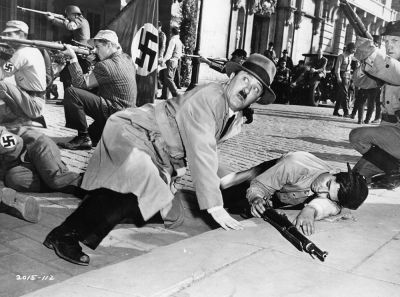
THE HITLER GANG
(USA/1944) R.: John Farrow. D.: 95'. V. inglese
Scen.: Frances Goodrich, Albert Hackett, Kurt Neumann. F.: Ernest Laszlo. M.: Eda Warren. Scgf.: Hans Dreier, Franz Bachelin. Mus.: David Buttolph. Int.: Robert Watson (Adolf Hitler), Roman Bohnen (Ernst Röhm), Martin Kosleck (Joseph Goebbels), Victor Varconi (Rudolph Hess), Luis Van Rooten (Heinrich Himmler), Alex Pope (Hermann Göring), Ivan Triesault (Pastor Niemöller), Poldi Dur (Geli Raubal), Sig Ruman (generale von Hindenburg), Reinhold Schünzel (generale Ludendorff), Alexander Granach (Julius Streicher), Fritz Kortner (Gregor Strasser). Prod.: Paramount Pictures
35mm. D.: 95'. Bn. Versione inglese / English version
Da: Universal
Come indicato dal titolo, The Hitler Gang ritrae l'aspetto più triviale del Terzo Reich (e lo fa da un punto di osservazione sorprendente, il 1944): fiacco umorismo, battute cifrate, cattivo gusto, la sgradevolezza con cui i personaggi parlano gli uni degli altri ("perché perder tempo per quel miserabile nanerottolo" chiede Rosenberg, riferendosi a Goebbels). Il film, notevolmente fedele ai fatti, sottolinea l'aspetto gangsteristico del nazismo. L'umorismo non manca, ma neanche una fondamentale crudezza: finti suicidi ("era il primo uomo a essersi sparato alla testa cinque volte"), omicidi impuniti, esecuzioni brutali, l'allusione ai retroscena finanziari.
L'impostazione del film appare valida, anche se il più brillante critico di allora, James Agee, ne mise in dubbio "l'impegno solenne a rispettare i 'fatti'" e osservò che Hitler era "ben diverso da un meschino, feroce squilibrato incapace di una sola idea". Eppure, grazie all'ispirata regia di John Farrow, il film va oltre il semplice divertimento e si sforza di elaborare un'indagine sulla falsariga dei metodi psicoanalitici impiegati all'epoca per analizzare il profilo di Hitler.
Il punto di vista è sufficientemente chiaro: Hitler è un truffatore e un codardo, Göring finisce in una clinica psichiatrica svedese (dove avrebbe ovviamente dovuto restare). Ma Agee lamentava che il film sembrasse "suggerire, con il rispettoso ritratto di Gregor Strasser, che il nazionalsocialismo sarebbe stato accettabile se solo fossero stati eliminati gli spietati capobanda". Ciò che però affascinava Agee e non mancherà di affascinare anche noi è la dimensione da museo delle cere: nella gara dei sosia cinematografici di Hitler (mettendo da parte Chaplin), The Hitler Gang non sfigura accanto ai film di Čiaureli, Pabst e Sokurov. Il notevole attore che impersona Hitler è Robert Watson. Il cast non contava star di levatura internazionale, anche se alcuni volti sono riconoscibili: l'estone Ivan Triesault, il controverso Reinhold Schünzel (genio stravagante che riuscì a vivere e a lavorare nella Germania nazista fino al 1937), il mitico viennese Fritz Kortner (che si era formato nella cerchia teatrale di Max Reinhardt) e Sig Rumann, che era poco prima apparso nel magnifico ruolo del colonnello nazista in Vogliamo vivere! (1942) e che offre qui un'interpretazione particolarmente misurata.
Peter von Bagh
As the title indicates, The Hitler Gang depicts the trivial side of the Third Reich from an astonishing moment in time - 1944! - weak humor, inside jokes, utter tastelessness, a sick way of talking about comrades ("why waste time for that miserable little dwarf," asks Rosenberg, referring to Goebbels). It's based remarkably close to the facts in a way that accentuates the Nazi movement's proximity to gangsterism. There is plenty of humor but a fundamental toughness as well: faked suicides ("he was the first man who ever shot himself in the head five times..."), murders that go unpunished, brutal executions, plus a view of the movement's financial background. The approach makes sense even if the brightest contemporary critic, James Agee, rather doubted its "solemn effort to stick to 'facts'" and noted that Hitler was "something other than a pitiful, vicious psychotic incapable of an idea". Still, due to John Farrow's inspired direction, the film is more than mere fun - it's an effort to develop a character study along the same lines as the psychoanalytic treatments then under way analyzing Hitler's profile.
With Hitler a swindler and coward, and Göring in a Swedish mental institute (where he obviously should have been kept), the point of view is clear enough. Yet Agee protested the "apparent suggestion - through the respectful portrayal of Gregor Strasser - that there would be nothing wrong with National Socialism if only the vicious ringleaders were eliminated".
What fascinated Agee, however, and will fascinate us today, is the film's waxworks dimension; this is surely the best American entry in the look-alike competition for the Hitler role (assuming we don't include Chaplin), ready to compete (although loosely) with the variants created in the films of Čiaureli, Pabst or Sokurov. The name of the remarkable Hitler actor is Robert Watson - the entourage included no internationally known stars. Yet, some come close or are recognizable faces: the Estonian-born Ivan Triesault, the controversial Reinhold Schünzel (the extravagant light genius who stayed and joked in Nazi Germany up until 1937), the legendary Viennese Fritz Kortner, from Max Reinhardt's theatrical circle, plus Sig Rumann, the actor of a recent great Nazi role in To Be or Not to Be (1942), seen here with a remarkably subdued interpretation.
Peter von Bagh
Tariffe:

Numero posti: 144
Aria condizionata
Accesso e servizi per disabili
Il nostro cinema aderisce al circuito CinemAmico: è possibile utilizzare l’applicazione MovieReading® per i film di cui è prevista audiodescrizione e/o sottotitolazione sull'applicazione.
Tel. 0512195311











